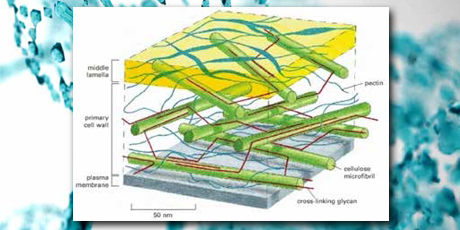
Better Utilization of Plant Cell Walls
The project presents synthesis of analogues to inhibitors of enzyme activity involved in degradation of hemicelluloses, a major group of plant wall components.
Utilization of biomass has attracted much interest, not only for bio-fuel production but also for a range of other products such as paper, food ingredients, dietary and industrial fibres, pharmaceuticals and nutraceuticals. The largest source of biomass is plant cell walls. However, processing of this type of biomass is challenging. The project presents synthesis of analogues to certain inhibitors of enzyme activity involved in degradation of hemicelluloses, which constitute the second largest group of plant wall components (next to celluloses). These enzyme inhibitor analogues may serve as tools to analyze and characterize key enzymes, and thus contribute to the understanding of hemicelluloses.
The plant cell wall is a composite of many different polysaccharides, proteins and aromatic substances. The polysaccharides are constructed of complex carbohydrates. The main group is celluloses which – among other functions – can form microfibrils, which serve as the core of the plant wall contributing strongly to the overall structural stability of the plant.
Hemicelluloses are low-molecular-weight polysaccharides that strengthen the cell walls through their interaction with celluloses. Xylan-type polysaccharides are a major group of hemicelluloses components, constituting about 20-30 % of the biomass of hardwoods and up to 50 % in grasses. Examples of xylan-type hemicelluloses components are xyloglucans, arabinoxylans, and glucoarabinoxylans.
The synthesis of hemicelluloses is catalyzed by a group of enzymes, the glycosyltransferases. It is generally accepted that understanding of the enzymatic processes which regulate both synthesis and degradation of hemicelluloses will be important in order to optimize bio-refining. A promising path forward for such studies is to construct analogues of key components involved in the enzymatic processes.
In the project, methods for incorporation of thiolinkages in the synthesis of oligoxylans were developed.
One method involved 1-thioglycoside donors. Here, the protecting groups present on the acceptor were shown to influence the stability of the C4-triflate acceptor strongly and therefore also the yield of the coupling reaction.
In a second strategy involving thioacceptors, the type of glycosyl donor employed proved to be critical for the success of the coupling.
Both routes were thoroughly investigated through by-product determination, and both were shown employable for the synthesis of thiolinkages in oligoxylans assembly.
Illustration:
Segment of the primary cell wall. Hemicellulose is represented here as cross-linking glycans10.